Ancient Olympic Games › Olympia » Ancient origins
Articles and Definitions › Contents
- Ancient Olympic Games › Antique Origins
- Olympia › Ancient History
Ancient civilizations › Historical and archaeological sites
Ancient Olympic Games › Antique Origins
Definition and Origins
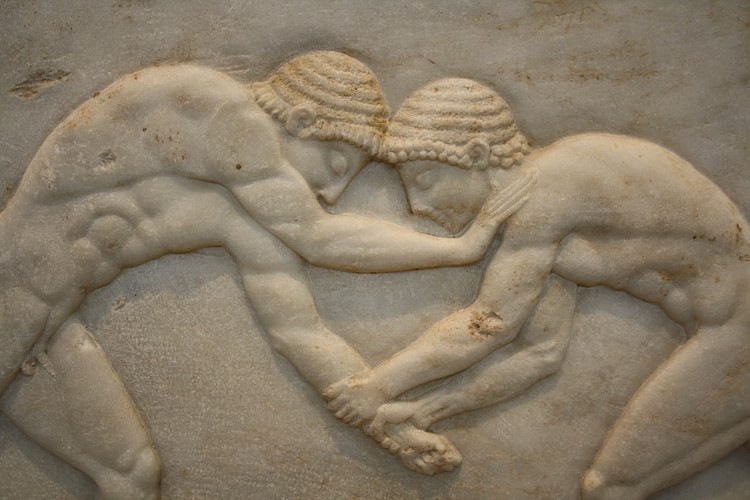
The ancient Olympic Games were a sporting event held every four years at the sacred site of Olympia, in the western Peloponnese, in honour of Zeus, the supreme god of Greek religion. Involving participants and spectators from all over Greece and even beyond, the Games were the most important cultural event in ancient Greece and were held from 776 BCE to 393 CE, a run of 293 consecutive Olympiads. So important were the Games in the ancient world that they were even used as a basis for the calendar.
ORIGINS OF THE GAMES
Sporting events were originally associated with funeral rituals, particularly those of heroes and the fallen in battle, for example, the games for Patroklos in Homer ’s Iliad. At Olympia, in particular, some mythological accounts credit Zeus with beginning the Games to celebrate his victory over Kronos whilst other accounts state the hero Pelops began them in honour of Oinomaos. In any case, sport, a healthy body and the competitive spirit were a large part of Greek education and so it is hardly surprising that organised athletic competitions would at some point be created, as they had been in the earlier Minoanand Mycenaean civilizations.
SPORT, A HEALTHY BODY & THE COMPETITIVE SPIRIT WERE A LARGE PART OF GREEK EDUCATION.
The first Olympics were held from 776 BCE at the first full moon after the summer solstice (around the middle of July) in honour of Zeus. The winner of the first and only event, the stadion foot-race was Koroibos of Elis and from then on every victor was recorded and each Olympiad named after them, thus giving us the first accurate chronology of the ancient Greek world.An Olympiad was not only the name of the event itself but also of the period between games. During a three-month pan - Hellenic truce, athletes and as many as 40,000 spectators came from all over Greece to participate in the Games at Olympia.Later, other games would be organised at other sacred sites such as Delphi, Isthmia and Nemea but the Olympian Games would remain the most prestigious.
The Games started with a procession which went from the host town of Elis to Olympia, led by the Hellanodikai (judges) and on arrival at Olympia all athletes and officials swore an oath to follow the established rules of the competitions and to compete with honour and respect. The most important religious ceremony of the event was the sacrifice of 100 oxen, known as the hecatomb, at the altar of Zeus, carried out when the sporting events were over.
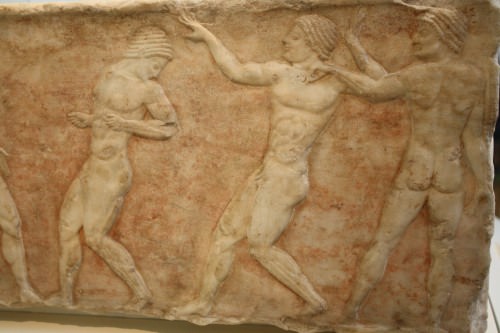
Greek Athletes
THE SPECTATORS
Heralds ( spondophoroi ) were sent from Elis to advertise the coming of the Games across Greece. Spectators came from not only the Greek mainland but also the islands, Ionia and Magna Graecia. To facilitate the movement of spectators and athletes and in respect of the religious importance of the Games a sacred truce ( ekecheiria ) was called across Greece.Initially, the truce was for one month but in later centuries it was extended to three. No wars were permitted, no arms could be carried in the territory of Elis and no hindrance was to be given to any spectator, athlete or theoriai - (the official missions representing particular cities ) travelling to the games from wherever they came from and whichever territory they had to cross.
The site of Olympia must have been positively buzzing during a Games with mass crowds of excited spectators staying in make-shift camp sites (only later was accommodation provided for the visitors) and admiring the masses of fine statues and buildings at the site. Food vendors, craftsmen, musicians, poets and philosophers took full advantage of the crowds to publicise their wares or ideas. Just how many spectators attended each Games is unknown but we do know that around 45,000 spectators consisting of men, slaves and foreigners sat and watched from the embankments of the stadium which hosted the main events. Spectators actively participated in the events through their boisterous support of the athletes and after each event they showered flowers and laurel leaves on the victors.
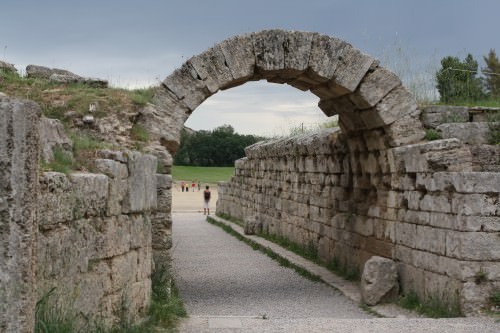
Stadium Entrance, Olympia
Women were not permitted to participate in or watch the events although young girls were allowed in the crowd. There was a single exception to this rule, the priestess of Demeter Chamyne. A famous breach of the men only rule was the case of Kallipateira. She had trained her son Peisirodos and when he won his race his mother, celebrating a little too exuberantly in the crowd, loosened her clothes and revealed her sex. She escaped the prescribed punishment of the death penalty because she came from a family of great Olympic victors but from then on all trainers had to be naked - like the athletes - to avoid such an occurrence in the future.
THE ATHLETES
WHO OF MEN TODAY HAS BEEN ADORNED WITH SO MANY PETALS AND MYRTLES AND CROWNS OF ROSE THANKS TO HIS VICTORY IN THE GAMES? SIMONIDES' ODE TO ASTYLOS
Athletes trained under the watchful eye of a professional trainer ( gymnastes ) or physical trainer ( paidotribes ) who knew how to best develop particular muscles, the best diet and the correct amount of exercises to be done. Trainers were often thanked by their more successful athletes by the dedication of a statue of them at the site. Athletes also had an aleiptes who rubbed them down with oil and massaged them both before exercising and after.
The athletes competed naked, probably for complete freedom of movement. Events were open to all free Greek males and the list of victors illustrates just how pan-Hellenic the Games were with athletes coming from all parts of Greece and in Romantimes the no-foreigner rule for athletes was relaxed. Victors were those who beat all other competitors. There are practically no records of times and distances achieved by victorious athletes as these were simply not considered important, the idea was to be first amongst the best, not to beat records.
THE STADION FOOTRACE
For the first 12 Olympics the stadion foot-race was the only event and it remained the most prestigious event throughout the history of the Games. The race was ran over one length (a stadion ) of the stadium track, 600 ancient feet or 192 m and preliminary heats were held with heat winners going into the final. Athletes were grouped by lot and in the interest of fairness this was also the way pairings were matched in the other events. The eventual winner of the stadion would even give his name to that particular Games and so be remembered for all time.
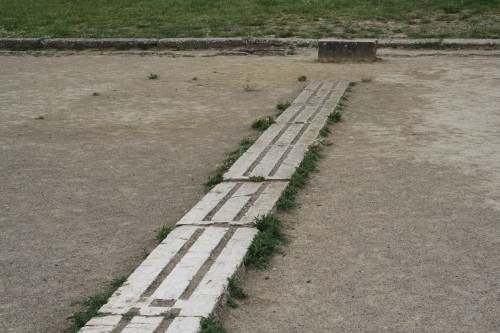
Starting Blocks, Olympia
OTHER SPORTING EVENTS
Over time other events were added to the Games to bring the total programme to 18 events spread over five days:
- diaulos - the two stadium lengths foot-race, added in 724 BCE.
- dolichos - longer foot-races 7 to 20 stadium lengths, added in 720 BCE.
- wrestling - added in 708 BCE. Competitors had to throw their opponent to the ground three times to gain victory.
- pentathlon - also added in 708 BCE. All done in a single day, the event order was: jumping (in a soft soil pit using hand-weights or halteres and accompanied to music), discuss (in stone, iron or bronze), stadion, javelin (in wood and thrown using a leather thong), and wrestling. Just how an athlete won the overall event is unclear, three event victories may have guaranteed overall victory.
- boxing - added in 688 BCE. Athletes wore straps of leather ( himantes ) around their hands, initially as protection but they evolved into destructive weapons with metal pieces added. Rules were limited to no low-blows and no holding. Serious injuries were common and deaths not unknown.
- tethrippon - the four-horse chariot race added in 680 BCE, run over ten or twelve circuits of the hippodrome. A version using foals over 8 circuits was added in 384 BCE.
- keles - a horse race added in 648 BCE and run over 6 cicuits. A version for foals was added in 256 BCE.
- pankration - a mix of boxing and wrestling also added in 648 BCE. The pankration was a brutal event and the only moves not allowed were biting and gouging, although competitors did not wear the damaging leather thongs of the boxers.
- hoplitodromos - the race in hoplite armour (helmet, shield and spear) between 2 and 4 stadium lengths was added in 520 BCE and was usually the last event of the Games.
- apene - a race with chariots pulled by two mules, added in 500 BCE (dropped from 444 BCE).
- kalpe - a trotting horse race for mares, added in 496 BCE (dropped from 444 BCE).
- synoris - the two-horse chariot race run over eight circuits of the hippodrome, added in 408 BCE. A version using foals over three circuits was added in 268 BCE.
- competitions for trumpeters and heralds - added in 396 BCE. This was held on the first day and the winners - those whose sound carried the furthest - were also given the honour of announcing the victors on the final day at the official prize-giving event.
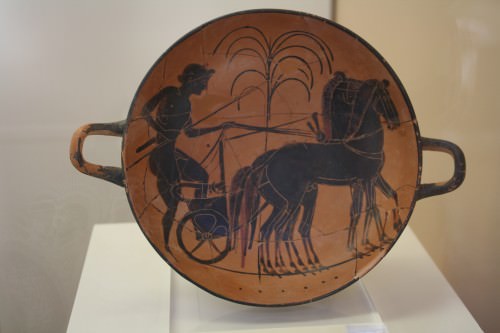 GREEK CHARIOT
GREEK CHARIOT

COMPETITION RULES & JUDGES
Athletes had to arrive at Olympia one month before the Games for training and, further, they had to declare that they had been in training for at least ten months. Non-Greeks, slaves, murderers, those convicted of defiling temples and all those who had not respected the truce were excluded from participating. Indeed, cities could be included in the latter category, for example, Sparta in 420 BCE.
THE HELLANODIKAI JUDGES HAD THE POWER TO DISQUALIFY & FINE ATHLETES FOR ANY INFRINGEMENT OF THE RULES.
The events were supervised by trained judges from Elis, the Hellanodikai (or agonothetai ) who also had various assistants such as the alytai (police officers). For the first 49 Olympics there was only one judge but he was joined by others to reach a peak of twelve, distributed amongst the various events. Originally, the office was hereditary and for life but later judges were selected from Elis by lot. The Hellanodikai had the power to disqualify and fine athletes for any infringement of the rules and, wearing their purple cloaks, they were given special seats of honour in the stadium. The decisions of the Hellanodikai could never be revoked but the judges were themselves subject to judgment from a council of elders and should an athlete successfully appeal, the judge concerned could be fined.
Rules were very rarely broken and when they were penalties were imposed ranging from exclusion and fines to flogging. Fines were paid both to the sanctuary and the wronged athlete. If an offender did not pay the fine then the city he represented had to or else be excluded from the next Games. Revenue from fines was in part used to erect statues of Zeus known as zanesand a number of the bases of these statues can still be seen at the site today.
OLYMPIC PRIZES
The Hellanodikai also gave out the victory crown ( kotinos ) of wild olive leaves and an olive branch cut from the scared tree ( Kallistephanos ) to each event winner. The olive was significant because the trees of Olympia were believed to have been originally planted by Hercules. Another prize could be a red woollen ribbon which was worn on the upper arm or around the head, especially for chariot racers as it was the horse owner who actually received the olive crown.
Victors were welcomed back to their hometowns as heroes after the Games. Typically entering the city in a procession where they rode a four-horse chariot, the victors had huge banquets held in their honour and they could receive additional benefits such as exemption from tax and invitations to join the political elite. Cities also received prestige from victories at the Games and for this reason they sometimes offered financial incentives for athletes such as Solon ’s 500 drachmas prize (a substantial sum considering one sheep cost one drachma at the time).
However, the real prize for athletes was glory, fame and, in a very real sense, historical immortality. This was achieved through renown whilst still alive but was perpetuated after death via victor's lists, personal statues and victory odes written in the victor's honour.
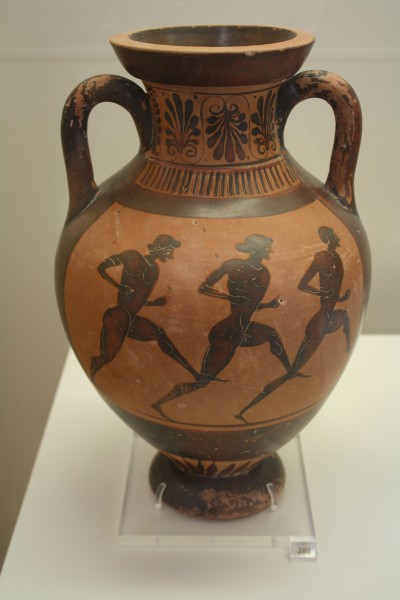
Greek Foot Race
FAMOUS OLYMPIANS
There were many great athletes who won fame and glory in multiple Games. Kroton from southern Italy won three consecutive stadion races from 488 to 480 BCE. Phanas of Pellene managed to win three events in the Olympics of 521 BCE - the stadion, diaulos and the race in armour. Leonidas of Rhodes went even better and managed to win all three events in four consecutive Olympics between 164 and 152 BCE. A feat almost matched by Hermogenes of Xanthos, known as 'the horse' who won eight running events over three Olympics between 81 and 89 CE. Milon of Kroton won the wrestling competition five times from 532 to 516 BCE and the runner Astylos of Kroton won six crowns across the three Olympics of 488, 484 and 480 BCE. Finally, Herodoros of Megara won an incredible ten consecutive trumpet competitions from 328 to 292 BCE.
The Games and their prestige also attracted famous competitors from outside the sporting world. The great Athenian general and statesman Alcibiades won three chariot races in 416 BCE. Philip II of Macedon won the horse race in 356 BCE and repeated his winning streak in the chariot races of the 352 and 348 BCE Games. Also, Roman emperor Nero famously won every event he entered in 65 CE. These powerful political leaders even sought to milk the prestige of their successes at Olympia by minting coins to commemorate their victories.
The first woman to win the crown of victory was Kyniska in 392 BCE. Although women were not permitted to compete, they could own horses and it was the owner who won the olive crown prize. Many other women went on to emulate Kyniska and Spartan women, in particular, enjoyed a high reputation in the equestrian events at Olympia.
END OF THE GAMES
The Games continued through the Hellenistic period with more buildings added to the site, greater comforts offered for the spectators and an increase in the professionalism and event specialisation of the athletes. In Roman times, although there were some changes to tradition such as Sulla ’s moving of the 80 BCE Games to Rome, the Games continued to be popular and their prestige increased under hellenophile emperors such as Hadrian. However, it was Emperor Theodosios who finally decreed that all cult practices, including Games, be stopped and the final Olympics was held in 393 CE after a run of 293 Olympics over more than a millennium.
Olympia › Ancient History
Definition and Origins

Located in the western Peloponnese, Olympia was an ancient Greek sanctuary site dedicated to the worship of Zeus, in whose honour Pan - Hellenic Games were held every four years from 776 BCE to 393 CE.
First inhabited in the second millennium BCE, the first archaeological record of dwellings dates from 1900 to 1600 BCE. The Kronion hill at the site was perhaps the first place of worship, dedicated to Kronos. However, other sacred buildings at the foot of the hill in the sacred grove of wild olive trees, or Altis, indicate other deities were worshipped such as Gaia, Themis, Aphrodite, and Pelops. With the descent of western Greek tribes into the Peloponnese, though, it was Zeus, father of the Olympian gods, who would become the dominant cult figure at Olympia.
The first large building on the site was the Heraion, a temple dedicated to Hera built around 650-600 BCE. In the 5th century BCE the sanctuary reached its peak of prosperity, and a massive Doric 6 x 13 column temple was completed in 457 BCE in order to house a hug e cult statue of Zeus. Designed by Libon of Elis, the temple was the biggest in Greece at that time and measured 64.12 mx 27.68 m with columns 10.53 m in height. The pediments of the temple displayed magnificent sculpture: on the east side the mythical chariot race between Pelops and Oinomaos, and on the western pediment a Centauromachy with the majestic central figure of Apollo. Metopes from the temple represented the labours of Hercules. The statue of Zeus within the temple was by Phidias (who had worked on the Parthenon and its statue of Athena ) and was a 12 m high goldand ivory representation of Zeus seated on a throne and regarded as one of the Seven Wonders of the Ancient World. Other important building projects over the centuries included baths and a swimming pool (5th century BCE), the new stadium with embankments for spectators (mid-4th century BCE), a palaistra (3rd century BCE), a gymnasion (2nd century BCE), hippodrome (780 m long), the large Leonidaion or guest houses (330 BCE), and the Theikoloi (priest's residence).
THE FIRST OLYMPIC GAMES WERE HELD IN 776 BCE AT THE FIRST FULL MOON AFTER THE SUMMER SOLSTICE.
Sporting events were originally associated with funeral rituals, for example the funeral games instigated by Achilles in honour of Patroklos in Homer ’s Iliad. Some mythological accounts credit Zeus with beginning the Games to celebrate his victory over Kronos; other accounts state Pelops began them in honour of Oinomaos. In any case, sport, a healthy body and the competitive spirit were a large part of Greek education, and so it is hardly surprising that organised athletic competitions would at some point be created.
The first Olympic Games were held in 776 BCE at the first full moon after the summer solstice. The winner of the first and only event, the stadion foot-race (one length of the stadium track, 600 feet or 192 m), was Koroibos of Elis, and from then on every victor was recorded and each Olympiad named after them, thus giving us the first accurate chronology of the Greek world.During a three month Pan-Hellenic truce, athletes and as many as 40,000 spectators came from all over Greece to participate in the Games. Individuals and city -states brought offerings to Zeus which included money, statues (including the magnificent Nike of Paionios, c. 424 BCE, and the Hermes of Praxiteles, late 4th century BCE), bronze tripods, shields, helmets, and weapons resulting in Olympia becoming a living museum of Greek art and culture. Many cities also built treasuries - small but impressive buildings to house their offerings and raise the prestige of their city.
Over time other events were added to the Games such as longer foot-races, wrestling, boxing, chariot racing, discus, javelin, jumping, and the pentathlon. At its peak there were 18 events spread over five days. However, it was always the original stadion which remained the most important event. Victors won crowns of olive leaves and an olive branch cut from the scared grove, but much more importantly they won glory, fame, and in a very real sense historical immortality.
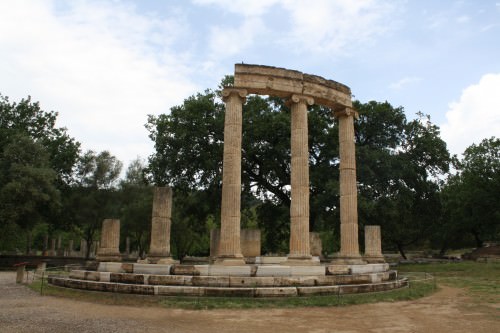
The Philippeion of Olympia
A second important event held at Olympia was the Heraia Games for women, held every four years in honour of the goddess, Hera. Children, adolescents, and young women ran in separate foot-races over 500 feet of the stadium track (160 m). Prizes for victors included olive crowns and the right to set up a portrait of themselves on the site. The responsibility for the organisation of both Games and for maintenance of the site when not in use lay with the Eleans.
The Games continued through the Hellenistic period with the notable architectural addition of the Philippeion, a circular colonnaded building erected by Philip II of Macedonia which contained gold statues of the royal family (c. 338 BCE). The Romans, whilst giving little importance to the religious significance of the Games, continued to hold them in high regard and despite the attempt by Sulla in 80 BCE to permanently move the Games to Rome, continued to embellish Olympia with new buildings, heated baths, fountains (notably the Nymphaion of Herodes Atticus, 150 CE), and statues. Most famously, emperor Nero strove to win the glory of Olympic victory in 67 CE, competing in, and unsurprisingly winning, every event he entered.
With Emperor Theodosios' decree to prohibit all cult practices, the Games came to an end in 393 CE after a run of 293 Olympics over more than a millennium. The site gradually fell into decline, was partially destroyed under the decree of emperor Theodosios II in 426 CE, and was taken over by a Christian community who built a basilica on the site in the early Byzantine period. Earthquakes in 522 and 551 CE destroyed much of the remaining ruins, and silt from the nearby rivers Alpheios and Kladeos eventually covered the site until its rediscovery in 1829 CE by the French Archaeological Mission and systematic excavation by the German Archaeological Institute from 1875 CE.
MAP
LICENSE:
Article based on information obtained from these sources:with permission from the Website Ancient History Encyclopedia
Content is available under License Creative Commons: Attribution-NonCommercial-ShareAlike 3.0 Unported. CC-BY-NC-SA License